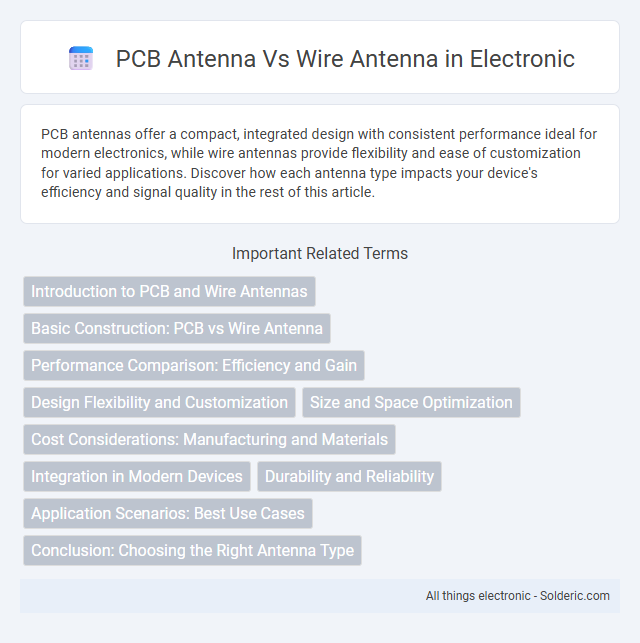PCB antennas offer a compact, integrated design with consistent performance ideal for modern electronics, while wire antennas provide flexibility and ease of customization for varied applications. Discover how each antenna type impacts your device's efficiency and signal quality in the rest of this article.
Comparison Table
| Feature | PCB Antenna | Wire Antenna |
|---|---|---|
| Design | Printed directly on PCB; compact and integrated | Standalone wire; flexible in shape and length |
| Size | Small and space-saving | Varies; generally larger than PCB antennas |
| Performance | Consistent; optimized for specific frequencies | Higher gain possible; depends on length and placement |
| Cost | Lower cost in mass production | Usually cost-effective but may require more assembly |
| Installation | Integrated, minimal external components | Needs careful placement and mounting |
| Durability | Protected by PCB; less prone to damage | More prone to physical damage or environmental effects |
| Application | IoT devices, compact wireless modules | Long-range communication, experimental setups |
Introduction to PCB and Wire Antennas
PCB antennas are printed circuit board-based antennas offering compact design, ease of integration, and consistent performance ideal for modern wireless devices. Wire antennas consist of physically stretched conductive wire elements that provide simple construction and broad frequency range but require more space and careful placement. Your choice depends on application size constraints, frequency requirements, and manufacturing complexity.
Basic Construction: PCB vs Wire Antenna
PCB antennas are fabricated directly onto the printed circuit board using copper traces, offering precise geometric patterns that enhance signal consistency and integration with the device. Wire antennas consist of metal wires or rods shaped and positioned externally or internally, providing flexibility in length and placement but often requiring extra space and mounting components. Your choice between PCB and wire antennas depends on design constraints, performance needs, and manufacturing considerations for optimal wireless communication.
Performance Comparison: Efficiency and Gain
PCB antennas typically offer higher efficiency and consistent gain due to precise manufacturing and controlled impedance. Wire antennas can achieve comparable gain in certain configurations but often suffer from variability in performance and lower efficiency caused by environmental factors and installation inconsistencies. The integrated design of PCB antennas enables optimized radiation patterns and minimized loss, making them preferable for compact, high-performance wireless applications.
Design Flexibility and Customization
PCB antennas offer superior design flexibility and customization compared to wire antennas, as they can be precisely shaped and integrated directly onto circuit boards to meet specific frequency and size requirements. Wire antennas, while simpler and easier to implement, lack detailed tuning capabilities and often require manual adjustments or additional components to optimize performance. Your choice depends on the need for compact, application-specific designs versus straightforward, cost-effective solutions.
Size and Space Optimization
PCB antennas offer superior size and space optimization by integrating directly onto the circuit board, eliminating the need for additional external components, which significantly reduces the overall device footprint. Wire antennas require more physical space for proper length and orientation, making them less ideal for compact or miniaturized electronics. Your choice in antenna design impacts the efficiency of space utilization crucial for modern, space-constrained applications.
Cost Considerations: Manufacturing and Materials
PCB antennas offer lower manufacturing costs due to automated mass production and minimal material usage, reducing labor and assembly expenses. Wire antennas, while inexpensive in raw material costs, often require manual assembly, increasing labor-related expenses and time. Overall, PCB antennas present a cost-effective solution for high-volume applications, whereas wire antennas may be more suitable for low-volume or prototype stages.
Integration in Modern Devices
PCB antennas offer seamless integration in modern devices due to their compact size and ability to be printed directly onto circuit boards, reducing space and assembly complexity compared to wire antennas. Wire antennas require additional components and careful placement, which can increase device bulk and impact design flexibility. Your choice depends on device size constraints and manufacturing efficiency, with PCB antennas often preferred in sleek, densely packed electronics.
Durability and Reliability
PCB antennas offer higher durability due to their rigid, integrated design that resists physical damage and environmental factors better than wire antennas. Wire antennas, while flexible, are more prone to wear, corrosion, and breakage, affecting long-term reliability in harsh conditions. Your choice should consider the application environment, as PCB antennas provide consistent performance and longevity in demanding settings.
Application Scenarios: Best Use Cases
PCB antennas excel in compact electronic devices like smartphones, wearables, and IoT sensors due to their small size and integration capabilities. Wire antennas are ideal for outdoor applications, such as ham radios and long-range communication systems, offering greater flexibility and improved signal range. Your choice depends on whether you prioritize miniaturization and integration or maximum signal performance in diverse environments.
Conclusion: Choosing the Right Antenna Type
PCB antennas offer compact size, consistent performance, and easy integration, making them ideal for space-constrained and high-volume applications. Wire antennas provide greater flexibility in design and length adjustment, allowing for tailored frequency response and enhanced range in custom or experimental setups. Selecting the appropriate antenna depends on balancing size constraints, performance requirements, and manufacturing considerations specific to the intended device and environment.
PCB antenna vs wire antenna Infographic

 solderic.com
solderic.com